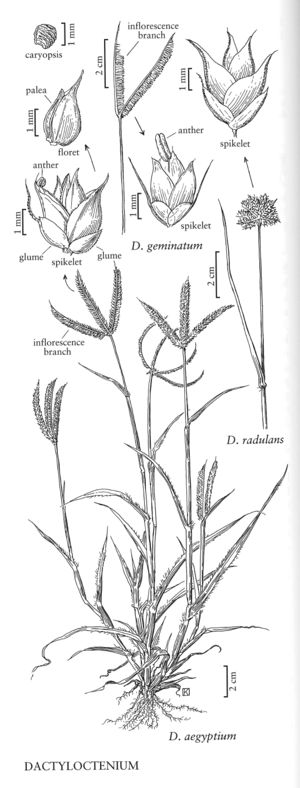Difference between revisions of "Dactyloctenium aegyptium"
FNA>Volume Importer |
imported>Volume Importer |
||
| (4 intermediate revisions by 2 users not shown) | |||
| Line 4: | Line 4: | ||
|publications= | |publications= | ||
|common_names=Durban crowfoot | |common_names=Durban crowfoot | ||
| + | |special_status={{Treatment/ID/Special_status | ||
| + | |code=I | ||
| + | |label=Introduced | ||
| + | }} | ||
|basionyms= | |basionyms= | ||
|synonyms= | |synonyms= | ||
| Line 17: | Line 21: | ||
-->{{Treatment/Body | -->{{Treatment/Body | ||
|distribution=Pacific Islands (Hawaii);Fla.;N.J.;N.Mex.;Tex.;La.;Tenn.;N.C.;S.C.;Pa.;N.Y.;Va.;Colo.;Calif.;Puerto Rico;Virgin Islands;Ala.;Ark.;Ill.;Ga.;Ariz.;Maine;Md.;Mass.;Ohio;Miss. | |distribution=Pacific Islands (Hawaii);Fla.;N.J.;N.Mex.;Tex.;La.;Tenn.;N.C.;S.C.;Pa.;N.Y.;Va.;Colo.;Calif.;Puerto Rico;Virgin Islands;Ala.;Ark.;Ill.;Ga.;Ariz.;Maine;Md.;Mass.;Ohio;Miss. | ||
| − | |discussion=<p>Dactyloctenium aegyptium is a widely distributed weed of disturbed sites in the Flora region. It is also considered a weed in southern Africa, but the seeds have been used for food and drink in times of famine. In addition, bruised young seeds have been used as a fish poison, and extracts are reputed to help kidney ailments and coughing (Koekemoer 1991). In Australia, it is planted as a sand stabilizer along the coast (Jacobs and Hastings 1993).</p> | + | |discussion=<p><i>Dactyloctenium aegyptium</i> is a widely distributed weed of disturbed sites in the Flora region. It is also considered a weed in southern Africa, but the seeds have been used for food and drink in times of famine. In addition, bruised young seeds have been used as a fish poison, and extracts are reputed to help kidney ailments and coughing (Koekemoer 1991). In Australia, it is planted as a sand stabilizer along the coast (Jacobs and Hastings 1993).</p> |
|tables= | |tables= | ||
|references= | |references= | ||
| Line 26: | Line 30: | ||
-->{{#Taxon: | -->{{#Taxon: | ||
name=Dactyloctenium aegyptium | name=Dactyloctenium aegyptium | ||
| − | |||
|authority=(L.) Willd. | |authority=(L.) Willd. | ||
|rank=species | |rank=species | ||
| Line 33: | Line 36: | ||
|basionyms= | |basionyms= | ||
|family=Poaceae | |family=Poaceae | ||
| − | |illustrator=Linda A. Vorobik | + | |illustrator=Linda A. Vorobik;Karen Klitz |
| + | |illustration copyright=Utah State University | ||
|distribution=Pacific Islands (Hawaii);Fla.;N.J.;N.Mex.;Tex.;La.;Tenn.;N.C.;S.C.;Pa.;N.Y.;Va.;Colo.;Calif.;Puerto Rico;Virgin Islands;Ala.;Ark.;Ill.;Ga.;Ariz.;Maine;Md.;Mass.;Ohio;Miss. | |distribution=Pacific Islands (Hawaii);Fla.;N.J.;N.Mex.;Tex.;La.;Tenn.;N.C.;S.C.;Pa.;N.Y.;Va.;Colo.;Calif.;Puerto Rico;Virgin Islands;Ala.;Ark.;Ill.;Ga.;Ariz.;Maine;Md.;Mass.;Ohio;Miss. | ||
|reference=None | |reference=None | ||
|publication title= | |publication title= | ||
|publication year= | |publication year= | ||
| − | |special status= | + | |special status=Introduced |
| − | |source xml=https:// | + | |source xml=https://bitbucket.org/aafc-mbb/fna-data-curation/src/200273ad09963decb8fc72550212de541d86569d/coarse_grained_fna_xml/V25/V25_183.xml |
|subfamily=Poaceae subfam. Chloridoideae | |subfamily=Poaceae subfam. Chloridoideae | ||
|tribe=Poaceae tribe Cynodonteae | |tribe=Poaceae tribe Cynodonteae | ||
Latest revision as of 17:58, 11 May 2021
Plants tufted annuals or short¬lived, shortly stoloniferous perennials. Culms 10-35(100) cm, usually geniculately ascending and rooting at the lower nodes. Sheaths keeled, with papillose-based hairs distally; ligules 0.5-1.5 mm, membranous, ciliate; blades 5-22 cm long, 2-8(12) mm wide, with papillose-based hairs. Panicle branches (1)2-6(8), 1.5-6 cm, only the first few spikelets in contact with the spikelets of adjacent branches; branch axes extending beyond the spikelets for 1-6 mm. Spikelets 3-4.5 mm long, about 3 mm wide. Glumes 1.5-2 mm; lower glumes ovate, acute; upper glumes oblong elliptic, obtuse, awned, awns 1-2.5 mm; lemmas 2.5-3.5 mm, ovate, midveins extended into curved, 0.5-1 mm awns; paleas about as long as the lemmas; anthers 0.5-0.8 mm, pale yellow. Seeds cuboid, about 1 mm long and wide, transversely rugose, light tan to reddish-brown. 2n = 20, 36, 40, 45, 48.
Distribution
Pacific Islands (Hawaii), Fla., N.J., N.Mex., Tex., La., Tenn., N.C., S.C., Pa., N.Y., Va., Colo., Calif., Puerto Rico, Virgin Islands, Ala., Ark., Ill., Ga., Ariz., Maine, Md., Mass., Ohio, Miss.
Discussion
Dactyloctenium aegyptium is a widely distributed weed of disturbed sites in the Flora region. It is also considered a weed in southern Africa, but the seeds have been used for food and drink in times of famine. In addition, bruised young seeds have been used as a fish poison, and extracts are reputed to help kidney ailments and coughing (Koekemoer 1991). In Australia, it is planted as a sand stabilizer along the coast (Jacobs and Hastings 1993).
Selected References
None.
